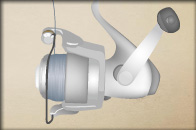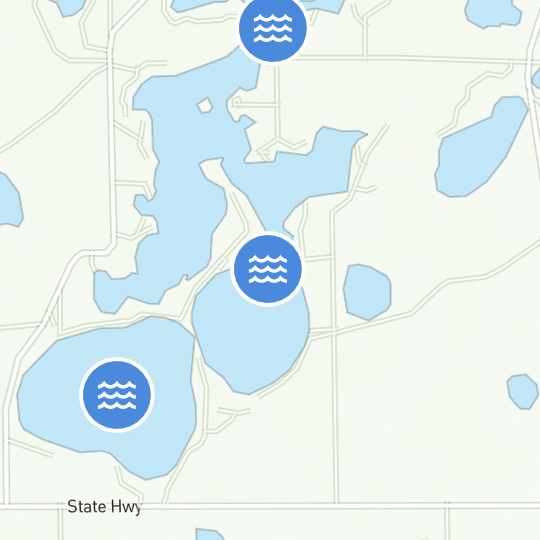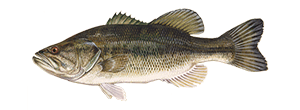Saltwater Rods & Reels
A good saltwater rod and reel are the foundation for successful saltwater fishing. Today’s saltwater rods and reels are high-tech tools that use space-age materials and precision workmanship to handle tough elements and tough fish.
Types of Saltwater Rods & Reels
Things to consider when purchasing saltwater rods and reels:
- Consider the length, power and action you need. Longer saltwater rods cast farther, while shorter rods provide more power for fighting fish. Action is rated from "fast" for a rod that is stiff to "slow" for a rod that bends all the way to the handle. "Power" is the weight that the rod can lift from light to extra heavy. Saltwater rods are also categorized by the pound-test line or lure weight that they are designed to work with.
- Most saltwater rods are made of graphite or fiberglass. Graphite rods are stiffer and more sensitive, while fiberglass rods are tougher and more powerful.
- Saltwater reels are classified as high-speed or low-speed. High-speed saltwater reels use a gear ratio greater than 6:1 to retrieve baits at breakneck speed. Low-speed saltwater reels, with a ratio less than 4:1, offer more power for fighting big fish. Some saltwater spinning reels even allow anglers to switch from high speed to low speed with the push of a button.
- Another quality to consider when picking out a reel is line capacity, which will usually be marked on the body of the reel in feet or yards per pound test of line. Drag pressure is measured in pounds and should be adjusted to one-third the breaking strength of the line.
- And remember, the best saltwater fishing reels are those that match the recommended line weights marked on the rod. To pick the right rod for the type of saltwater fishing you want to do, look at the recommended lure weight and match it to the size bait or lure you intend to use.
Spinning Rod And Reel
 Spinning gear uses a spinning reel with a fixed spool that is mounted below the spinning rod. Because the spool of the spinning reel is stationary, it is more difficult for the angler to tangle the line when casting spinning reels. For this reason, spinning rod and reel combos are among the most popular beginner fishing rods. A spinning rod will have wider guides to catch the large loops of line leaving the spool on the cast.
Spinning gear uses a spinning reel with a fixed spool that is mounted below the spinning rod. Because the spool of the spinning reel is stationary, it is more difficult for the angler to tangle the line when casting spinning reels. For this reason, spinning rod and reel combos are among the most popular beginner fishing rods. A spinning rod will have wider guides to catch the large loops of line leaving the spool on the cast.
Many anglers prefer spinning reels for working lures such as top-water poppers and high-speed plugs. Also, spinning reels can cast lighter saltwater lures and baits than conventional reels.
To fish with a spinning reel, hold the rod and reel in your dominant hand and crank the handle with the other hand. Most spinning reels have handles that are easy to change from left handed to right handed.
Spinning reels suffer from loops in the line called "wind knots" when the line becomes twisted or is not retrieved under pressure. This problem can usually be solved by adding a small swivel between the line and the leader.
When spooling line on a spinning rod, lay the spool on the floor so that the line is leaving the spool in the same direction that it is going onto the reel. To test if the line is going on correctly, pinch the line between your thumb and forefinger and make a dozen cranks of the reel handle. Then, stop winding line and drop the rod tip to put slack in the line. If the line starts to spin and twist, then you’re putting it on in the wrong direction. Simply flip the spool over and continue to fill the reel.
Baitcasting Rod And Reel
 Baitcasting reels hold more line, cast farther and produce smoother drag than spinning reels; however, baitcasting reels are more difficult to cast.
Baitcasting reels hold more line, cast farther and produce smoother drag than spinning reels; however, baitcasting reels are more difficult to cast.
A baitcasting reel has a revolving spool and sits on top of the baitcasting rod, which has smaller eyes than a spinning rod.
Baitcasting reels work well where long casts or big baits are necessary. Also, baitcasting reels are better for bottom fishing and jigging. Learn how to cast with baitcasting reels.
Reels with a closed face and line guide are used for working lighter lures and baits. Open-face reels without a line guide work better for casting or jigging because the line can be let out and retrieved more quickly.
One potential problem with baitcasting rods and reels comes when casting. If the spool is turning faster than the line is leaving the rod, the line gets backed up and explodes into a tangled mess called a "bird’s nest." If the backlash isn’t too severe, it can usually be picked out by pulling line off the reel.
To slow your cast, most baitcasting reels have either a magnetic, centrifugal or electronic cast control. But even with the best cast control, you still need to learn to use your thumb to slow the speed of the spool.
Saltwater Trolling Rod
A saltwater trolling rod is a beefed-up version of its baitcasting cousin with a revolving spool reel that sits on top of the rod. These are some characteristics of saltwater reels and rods:
- Saltwater trolling reels typically use a lever drag system instead of a star drag. This allows you to set the maximum drag, then adjust the amount of pressure with a lever on the side of the saltwater trolling reel. These reels also carry a lot of line and have large bodies to handle the extreme pressure of fighting a big fish.
- Saltwater trolling rods are shorter and stouter than casting rods with a notched butt that fits into the gimbal on a fighting belt or chair. Saltwater trolling rods either use high-strength round eyes or roller guides to support the line.
- Saltwater trolling rods and reels are categorized by the line-test that they are intended to support. A 20-pound combo will tackle smaller fish including sailfish, dolphin and white marlin; while a 130-pound outfit will subdue monster billfish and bluefin tuna.
- Saltwater trolling rods used for stand-up fishing will usually be shorter with a longer butt, while rods made to be used in a fighting chair will be longer with a shorter butt. Lighter action trolling combos also make good heavy-duty bottom fishing and bait fishing rods.
Saltwater Jigging Rods And Reels
Fishing with metal jigs is one of the oldest tricks in the book, but in recent years the method has taken on a new life with the invention of vertical and rubber jigs.
Vertical jigging uses high-speed rods and reels to retrieve a streamlined metal lure at top speeds. On the other hand, rubber jigs are designed to bounce slowly and hover off the bottom. These techniques require specialized tackle to either work a lure very quickly or very slowly.
For vertical jigging, use a medium-fast spinning or casting rod with a whippy tip that will quickly retrieve the jig. Vertical jigs require high-speed reels with a retrieve ratio of 6:1 or faster that can hold hundreds of yards of braided line.
Rubber jigs, on the other hand, are designed to move slowly and hover over their target. These jigs require an 8-foot, light-action rod that allows the fish to nibble its way to the hook without feeling any resistance. A reel with a slow retrieve ratio (below 5:1) will apply steady pressure to set the hook. Braided line and a highly sensitive rod will allow the angler to feel the slightest tap of a fish.
Visit our next section to learn more about saltwater fishing tools.
KEEP LEARNING

How to Tie the Non-Slip Loop Knot
The non-slip loop knot is a popular and reliable choice for securing hooks, lures, and other tackle to your fishing line.
LEARN MORE

Socials
Take me fishing social media links
LEARN MORE

TakeMeFishing x Teen Vogue
Join us on a creative journey as fashion designer Ahmrii Johnson walks us through her collaborative vision and process with Teen Vogue and fashion brand, Rentrayage, to create a special piece.
LEARN MORE


.png?lang=en-US&ext=.png)